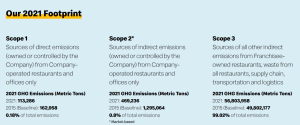McDonald’s reported a drop in US and global sales in Q2 2024, contrasting sharply with the previous year’s growth. Amid these challenges, the fast-food giant is doubling down on value deals and ambitious sustainability initiatives.
McDonald’s Sales Dip Amid Rising Costs
McDonald’s experienced a decline in US and global sales during the second quarter ending June 30, with decreases of 0.7% and 1.1%, respectively. This contrasts sharply with a 10% increase in US sales and a 12% increase in international sales during the same period last year.
The Chicago-based fast-food giant reported a net income of $2.02 billion, or $2.80 per share, down 12% from $2.31 billion, or $3.15 per share, in Q2 2023. Revenues remained flat at $6.49 billion, while systemwide sales decreased by 1%.
Higher prices have led consumers to seek value and lower-priced options, reducing traffic to McDonald’s. Despite these challenges, McDonald’s stock rose by more than 4% following the earnings release.
The increase is attributed to the company’s emphasis on its “$5 Meal Deal,” launched in late June, which targets budget-conscious customers. This strategy aims to attract customers increasingly focused on affordability, especially as prices of popular menu items like the Big Mac and Quarter Pounder have risen by over 20% in recent years.
McDonald’s focuses on value deals to retain and attract customers while addressing its massive carbon footprint at the same time.
McDonald’s Net Zero Strategy
In 2018, McDonald’s set ambitious targets to cut greenhouse gas (GHG) emissions from its restaurants and offices by 36%, and reduce emissions intensity across its supply chain by 31% by 2030 compared to 2015.
These targets, approved by the Science Based Targets initiative (SBTi), were supported by collaboration with industries, governments, Franchisees, suppliers, consumers, and local communities. In 2021, McDonald’s committed to aligning its climate goals with keeping global temperature rises below 1.5°C and achieving net-zero emissions by 2050.

Last year, McDonald’s set a fresh target for 2030 with 2018 baseline:
- Reduce absolute scope 1 and 2 GHG emissions from restaurants and offices by 50.4%
- Cut absolute scope 3 GHG emissions related to facility, logistics, and plastic packaging by 50.4%,
- Achieve a 16% reduction in scope 3 GHG emissions from beef and chicken farming (forests, land, and agriculture) by 2030
“We believe we have both a privilege and a responsibility to help lead on issues that matter most in communities – and there is no issue more urgent globally and of impact locally than protecting our planet for generations to come,” said Chris Kempczinski, McDonald’s President and Chief Executive Officer. He added that:
“By committing to net zero through the SBTi’s Business Ambition for 1.5°C campaign, we are helping every community we serve mitigate the impacts of climate change and adapt for the future.”
What McDonald’s Does to Cut Its Supersized Carbon Footprint
The fast-food giant’s net zero strategy revolves around transforming its food system, and supply chain and using renewable energy across its operations. All these targets align with SBTi’s 2023 guidance and the Greenhouse Gas Protocol, the global emissions accounting standard.
McDonald’s emphasizes that evolving climate accounting standards, especially for nature-based solutions like soil carbon sequestration and renewable energy, are crucial for meeting its targets. Balancing climate goals with company performance, including financial growth and innovation in menu offerings and sourcing, remains essential.
Expansion strategies might increase GHG emissions if decarbonization lags business growth. Navigating these challenges will be key to advancing McDonald’s climate targets while driving business forward.
Renewable Energy Impact
The company uses climate tracking data points to measure its energy impact. They have added two major U.S. virtual power purchase agreements (VPPAs) to boost renewable energy on the grid. They expect that their renewable energy projects once 100% operational can cut emissions by 33% from their 2015 baseline. Furthermore, their restaurants are run on renewable energy that meets Global Restaurant Standards (GRS).
Regenerative Agriculture
McDonald’s began regenerative agriculture with supply chain partners to combat deforestation and advocate for climate-positive policies globally. It had partnered with AgMission™ and FAI Farms, to promote sustainable farming.
McDonald’s targets key commodities—beef, soy (for chicken feed), palm oil, coffee, and fiber (for guest packaging)—to address deforestation risks. The strategy is reviewed with Proforest and WWF. McDonald’s also seeks to make a positive impact in other priority commodities.
Accelerating Circularity
A packaging and waste strategy aims to reduce waste and emissions throughout operations and the supply chain. more than 85.1% of restaurants in markets with advanced infrastructure offered guests the opportunity to recycle packaging items.
While McDonald’s faces declining sales, its commitment to ambitious carbon footprint reduction and sustainability goals shows its dedication to long-term growth and environmental responsibility.


